Easy recipe for Tsourike: Greek Easter Bread! Sweet yeast bread that is a bit brioche-like. You’ll love this traditional dense braided loaf that’s adorned with red-dyed eggs. You can serve it as part for brunch with a little honey and feta, or as part of your dinner feast next to other favorites like this Greek lamb. Be sure to watch the video below for how to make it!
Back in the spring of 2006, I was a part of a group tour to Turkey and Greece. And very fortunately, our time there coincided with the Greek Orthodox Easter.
In Greece, as in many Mediterranean cultures, Easter preparations begin on Holy Thursday with meaningful rituals, including dying eggs in red only–symbolizing rebirth, renewal, and the blood of Christ.
These same eggs are often used as decoration for the popular Greek Easter bread known as tsoureki, which is only one of many Easter breads and baked goods we encountered on our tour. In fact, you’ll find similar breads throughout the region to celebrate the holiday, like the Italian version that’s seasoned with citrus zest rather than anise and sesame.
What is Tsoureki Bread?
Tsoureki, Greek Easter bread, is a sweeter brioche-like bread that is enriched with eggs and butter–ingredients that are forbidden during the 48-day long Lenten season.
Traditionally, Greek Easter bread recipes, depend on flavoring from ingredients like mastic and mahleb, which are mostly accessible through the internet or Middle Eastern grocers.
I surveyed several recipes to come up with an easy, more accessible Greek Easter bread recipe. And for flavoring, I borrowed a bit of an Egyptian twist by adding anise seed, which is actually not too foreign to Greek baking. Some recipes also use fennel seed.
Traditions & Greek Easter Bread
As in many parts of the Mediterranean, Greek Orthodox Christians will celebrate Easter with a special midnight mass. A festive family dinner (or super early breakfast, if you will) follows. The star is typically meat; and many will serve a popular soup called magiritsa, which is made from the organs of the lamb.
The Hinarsises, my friends who supply our Greek extra virgin olive oil, confirmed that Greek Easter bread makes it’s appearance on Easter Sunday. It’s typically served following lunch– a big feast in which copious amounts of lamb are served.
And of course, red-dyed eggs are aplenty. As family members crack their eggs against each other in a playful but meaningful manner, one greets the other, “Christos Anesti” (meaning “Christ has risen”). The response, “Alithos Anesti” (meaning “Indeed, he did!”)
How to Serve It?
Today, Tsoureki is so popular that it’s mass produced, packaged, and sold and served almost throughout the year in Greece.
You may be sitting here going, I’m not Greek! But there really is no wrong way to serve and enjoy this Greek Easter Bread recipe. For my family, we will enjoy it for a simple breakfast with more boiled eggs, and feta, or honey.
Watch the Video for How to Make Greek Easter Bread:
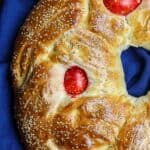
Easy Greek Easter Bread Recipe
- Total Time: 4 hours 45 minutes
- Yield: 1 large loaf (16 slices) 1x
Description
Tsourike: Greek Easter Bread is a sweet yeast bread that is a bit brioche-like. You’ll love this perfectly dense braided loaf that’s adorned with red-dyed eggs.
Ingredients
- 2 1/4 tsp active dry yeast (1 envelope)
- 5 1/2 cups all-purpose flour, more for dusting
- 1/2 cup sugar
- 1 1/3 cup milk
- 5 tbsp unsalted butter
- 1 tsp fine salt
- 2 large eggs, beaten, PLUS 1 egg beaten with 1 tsp water (egg wash)
- 2 tbsp anise seed
- 1/4 tsp vanilla extract
- 3 hard-boiled eggs, dyed red and fully dried
- Olive oil
- 2 to 4 tbsp toasted sesame seeds (optional)
Instructions
- In the bowl of a stand mixer, combine 1/3 cup hot water (about 110 degrees F) with the yeast, 1 tbsp of the flour, and 1 tbsp of the sugar. Whisk gently. Cover with a towel and leave aside for 10 minutes until bubbly.
- In the meantime, heat the milk in a small sauce pan until the edges begin to bubble, about 4 to 6 minutes. Remove from heat and stir in the butter, remaining sugar and salt. Set aside for 5 minutes to cool.
- Using the paddle attachment of your stand mixer, stir the milk mixture into the yeast mixture. While paddle is stirring, add the 2 beaten eggs. Gradually mix in the flour, anise seed, and vanilla extract. Beat unit a soft dough forms. Increase speed to medium (or medium-high if needed) until the dough pulls away from the sides of the bowl.
- Transfer dough onto a lightly floured surface (dough will be sticky at this point.) Kneed by hand until very smooth (about 5 minutes), then place dough into a lightly-oiled bowl. Cover and place in a warm, closed space for 1 1/2 hours, until doubled in size. (I had heated my oven to lowest temperature, then turned it off a few minutes before placing my covered dough in.)
- Punch dough down, and transfer to floured surface again. Cut dough into 3 equal parts, and gently roll each to form a long 16-inch rope. Transfer to a large baking sheet lined with parchment paper. Press ropes together at one end and braid fairly loosely. Form into a circle and press together on the other side. Stretch the circle to about 10 inches across and the hole in the middle about 3 1/2 inches wide.
- Cover with a clean towel and place back in warm space for 1 hour until doubled in size.
- Rub the dyed eggs with olive oil, and buff with paper towel. Select three spots in the dough, evenly spaced, and gently insert the eggs. Cover and return to warm space. Let rise 1 more hour until dough doubles in size.
- Heat oven to 350 degrees F. Brush the bread with the egg wash and sprinkle with toasted sesame seeds. Bake about 45 minutes until braided loaf turns a nice deep golden brown (should sound hallow when you tap on it.)
- Let cool for about 30 minutes before serving. Serve with more boiled eggs, honey or other breakfast items. Enjoy!
Notes
- Cook’s Tip 1: Make the boiled eggs and dye them first. Set aside to fully dry before use in this bread recipe.
- Are the eggs within the bread edible? We simply sliced around the eggs and did not eat them, they had been boiled then baked with the bread.
- Additional Notes: Traditional recipes rely on mastic and mahlab for flavoring. This modern recipe is tailored for the North American kitchen, relying on anise seed for flavor and topped with toasted sesame for added texture. You can use toasted slivered almonds in place of sesame seeds, if you prefer
- Recommended for this Recipe: Our Private Reserve Greek extra virgin olive oil (from organically grown and processed Koroneiki olives!)
- Visit The Mediterranean Dish store for quality Greek extra virgin olive oils and spices.
- Prep Time: 4 hours (3 1/2 hours inactive time)
- Cook Time: 45 mins
- Category: Bread
- Method: Baked
- Cuisine: Greek
Try these delicious recipes:
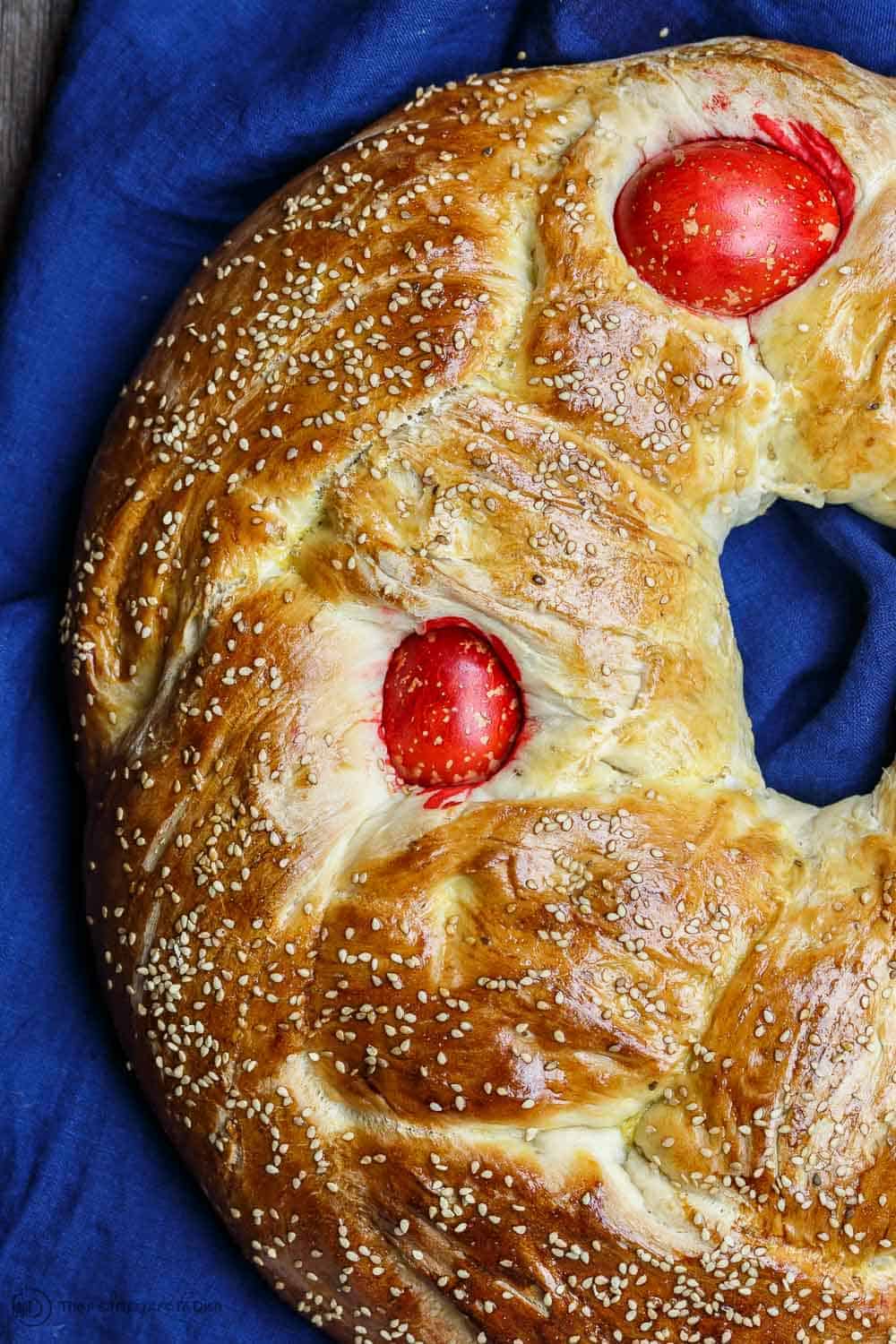
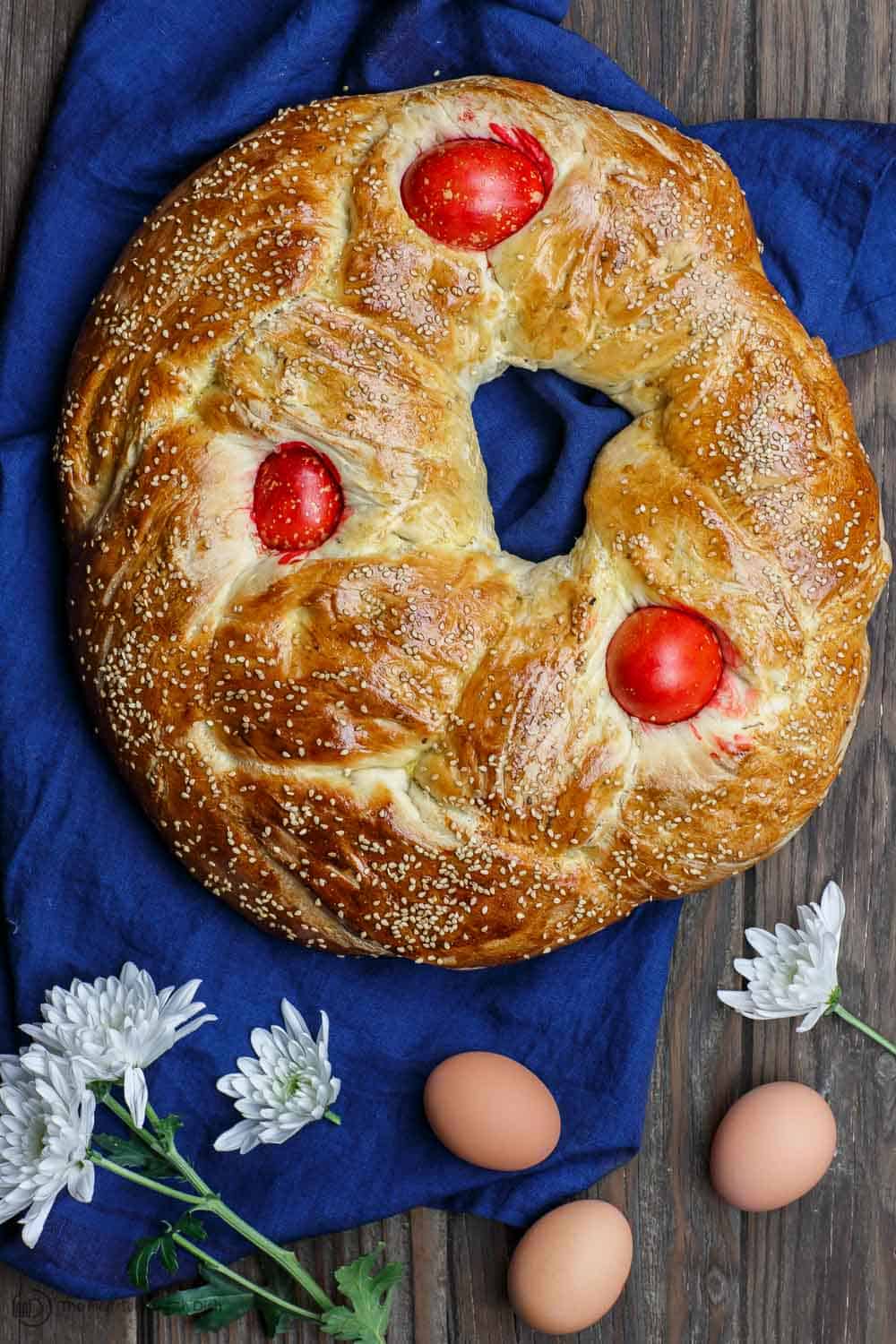
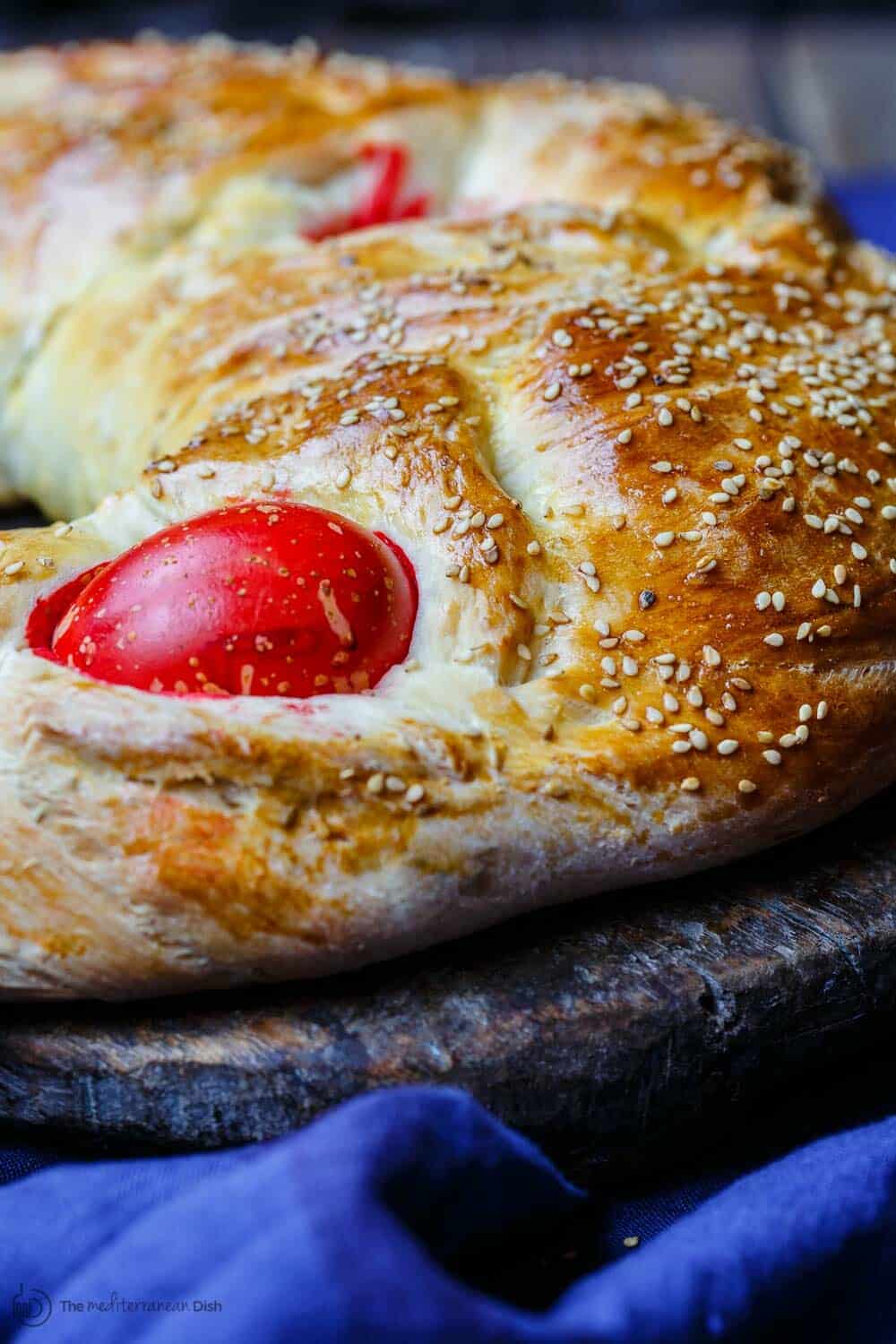
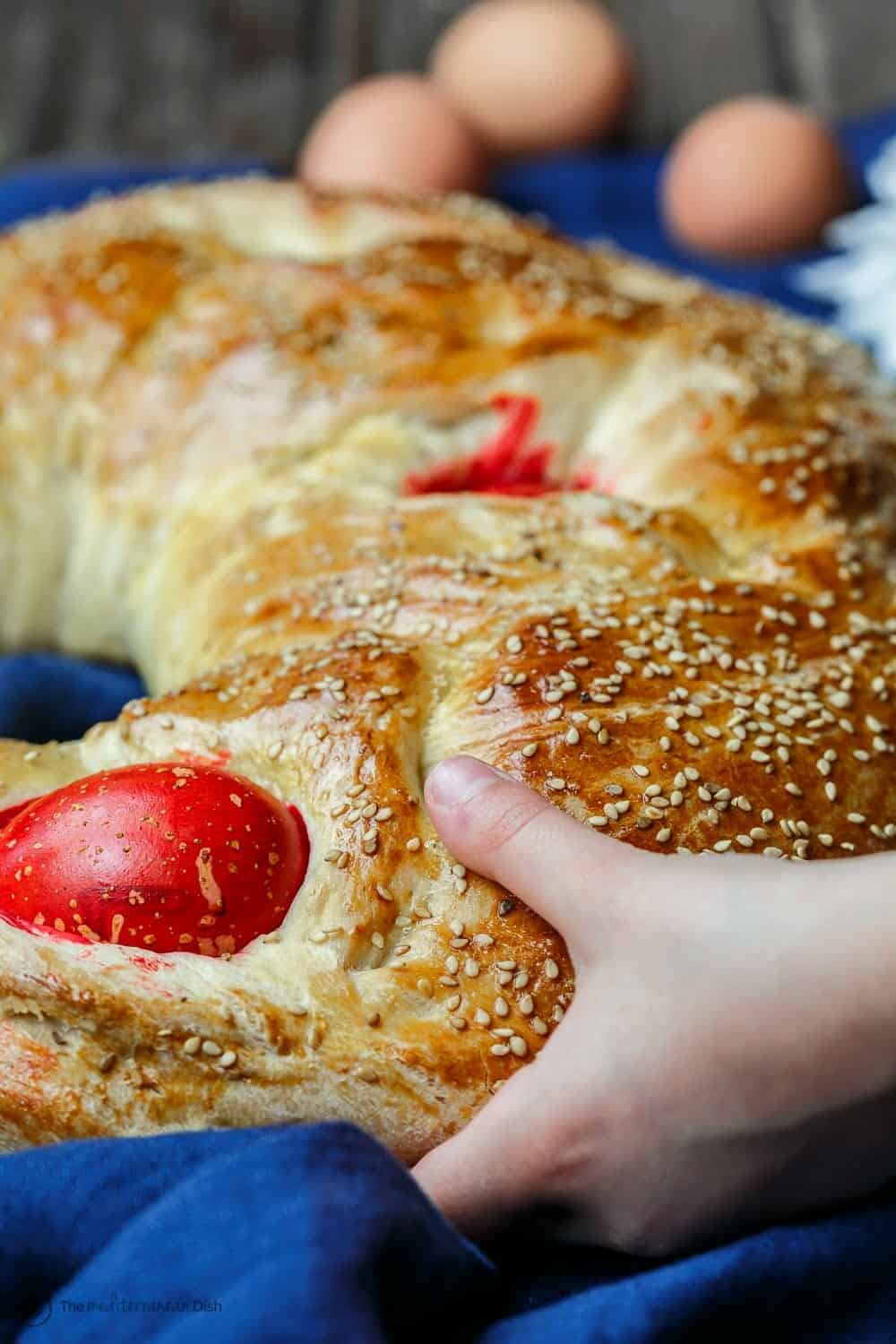
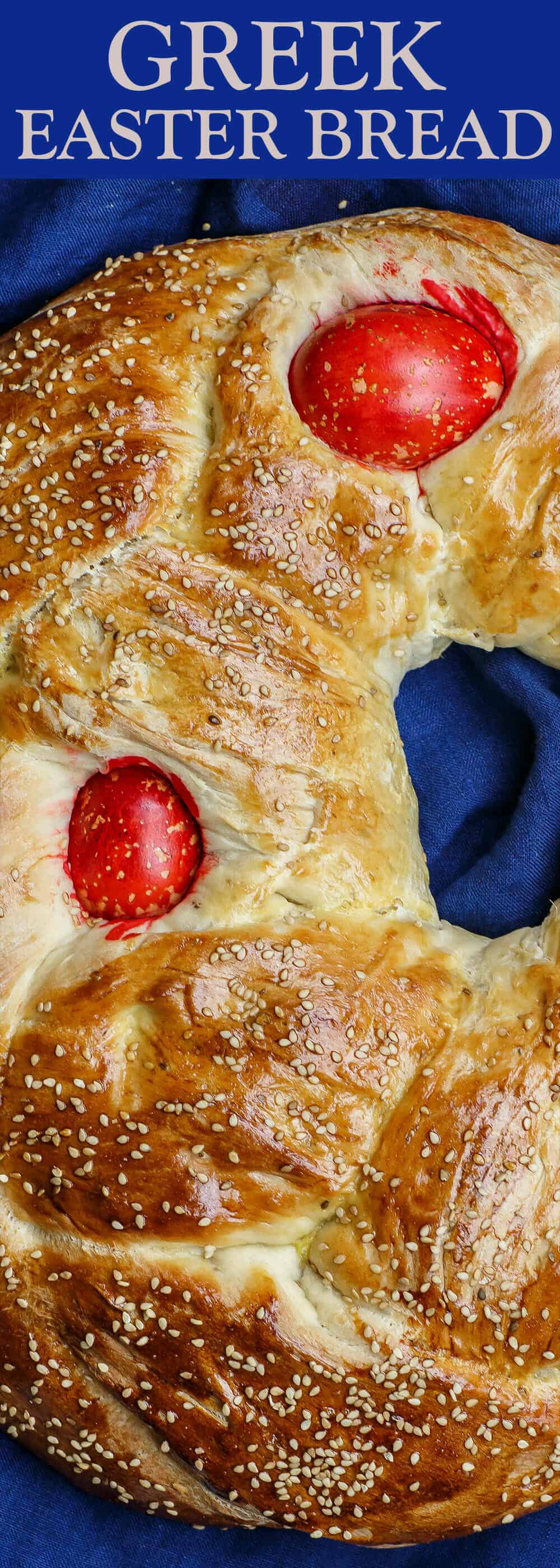
My father was Greek and with every Easter celebration this was present. I have thought about it and searched for it in the bakeries and then found this recipe and gave it a try. I didn’t really care if it tasted good I just wanted the symbolism to remind me of my father and his heritage. Imagine my surprise when it came out perfectly beautiful and so delicious! This is the second year I will be making it and I am so thankful for your simple to follow directions! Happy Easter
Thank you Kathy! This means a lot to me! Happy Easter to you, as well!
I made this for my Greek Friends this weekend, as we always do Greek Easter together, but due to circumstances this year we did my Sicilian Easter date at my house. My friend grilled her luscious Greek Lamb chops on my deck, and I made all the sides. Iman Bayaldi, Greek fasouli, lemon oven roasted potatoes, greek salad, and koulourakia for dessert.
First time I ever tried to make Greek Easter Bread- but really wanted to go for it, and am not a big bread baker- but just did the recipie, didn’t watch the video, and came about beautiful- totally in looks, and taste like the the classic real deal. First Try- WOW! Thankyou Dear Suzy, for the recipie- and I am thrilled while searching for the recipe, that I found your great blog web site
So glad to hear it, Bonita! Thanks so much for sharing!
I’ve made this bread before, however, couldn’t find my recipe. In searching for recipe like the one I’ve used in past, your version is close to perfect. Thank you for explicitness. You’re the best.
Wonderful, Patricia! This Easter bread is a family favorite. Enjoy!
Love learning about other Easter traditions! This looks great!
Love the pop of color from the dyed eggs!
Such a classic, I love this bread for Easter
The best, eh?!
My Italian great-grandmother made a similar bread, but the eggs were dyed raw and then they “baked” as the bread baked. They were edible and not double boiled/baked.
YES! there is an Italian version so similar! Thanks for sharing!
I wonder why you still mention only F degrees, and not add Celsius degrees for your international readers
I have never heard of Greek Easter Bread before but it is gorgeous! What a great addition to my Easter spread this will make!
So good!
I have never heard of Greek Easter Bread before but it is gorgeous!
So good! Thanks for stopping in.
I have never seen one of these Greek Easter bread wreaths in the flesh. Glad to know so much more about them.
Awesome! Glad you stopped in, love!
This bread sounds so good!
We LOVE it!
What a lovely tradition and love the Greeting sounds so genuine
Christos Anesti ! Alithos Anesti !
Will remember this for life !
Isn’t it great?! Thanks so much for stopping by Hansa!
I love all of your recipes! How would you make this if you don’t have a stand mixer?
I would just use a large bowl and a wooden spoon to mix. It’s a bit more work for the first steps…after step 3, you really don’t use the mixer anyway.
And thank you, Jim, for the kind note. I’m glad you’re enjoying the recipes!
Loving them 🙂
Thanks for the Butcher Box link too. I signed up and it’s the greatest thing ever!!
Such a beautiful bread! Thank you for sharing!
Thanks for stopping in Jennifer!
What a beautiful, delicious Easter tradition!!
We love it! Thanks, Liz!